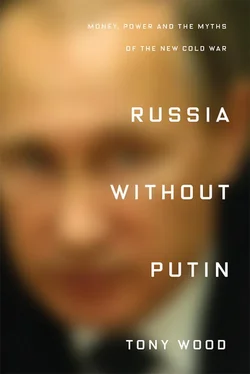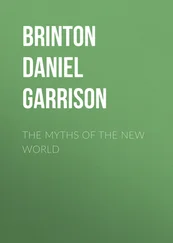The making of new social actors – oligarchs and racketeers, vagrants and shuttle traders – took place alongside what the anthropologist Caroline Humphrey has called ‘the unmaking of Soviet life’. {22} 22 Humphrey, The Unmaking of Soviet Life , pp. xvii–xviii.
The term applied in particular to three groups. Two of them had been the biggest beneficiaries of the Soviet system’s egalitarian elements: the working class, and women across the social spectrum. The third was the intelligentsia, which under Communism had experienced an ambiguous combination of repressions and advancements.
The Russian working class as a whole was ‘unmade’ in several ways during the 1990s. The sheer weight of industry within the Soviet economy – in 1980, it had accounted for 45 per cent of employment – meant that the post-Communist crisis was bound to have a disproportionate impact. {23} 23 Peter Nolan, China’s Rise, Russia’s Fall: Politics, Economics and Planning in the Transition from Stalinism , Houndmills 1995, p. 124, Table 5.2.
In effect, what took place repeated on a far larger scale the rust belt decay seen in much of the West. Many factories shed large portions of their workforce, pushing the official unemployment rate to 10 per cent in 1996; in 2000 it stood at 11 per cent. {24} 24 Figures cited in Cook, Postcommunist Welfare States , p. 64, Table 2.2.
This was actually not high by post-Communist standards: Poland posted a jobless figure of 13 per cent in 1995, and the unemployment rate in Lithuania in the same year was 18 per cent. {25} 25 Figures from World Bank Open Data website.
One reason Russia’s figure was not higher was because miserably low unemployment benefits put many people off registering (especially since they were often not paid out anyway). But more importantly, many state enterprises responded to the recession not by shedding workers but by reducing their hours or wages; in some cases they kept people on the books without paying them at all. Under- or pseudo-employment was a crucial lifeline for millions of Russians, supplying them with at least some income and continued access to the services and welfare that large-scale enterprises still provided. This also meant, though, that millions were obliged to make up the shortfall in income by taking up a whole range of other activities: factory workers moonlighted as cab drivers, engineers sold encyclopaedias, librarians cleaned apartments.
At the same time, the collective identity of the working class was being undone. The USSR had defined itself as a ‘workers’ state’, claiming – however rhetorically – a vanguard role in the global labour movement. The transition to capitalism, among many other things, meant a fundamental rejection of this received idea. Thanks to its association with the Communist regime, the very category ‘worker’ had been delegitimized at a stroke. Interviewing workers from a dozen factories over the course of the 1990s, French sociologist Karine Clément pointed to a process of what she called desubjectivation, as workers lost their sense of themselves and their place in the world. Many now refused any identification with the working class – and, often, with any social group at all; interviewees spoke again and again of their isolation, their lack of a future, their uselessness to society. ‘I am unsure of everything,’ said one; ‘I am a useless screw in a badly built car,’ said another, while others still observed that ‘I am not a man’ or that ‘I am a person on whom nothing depends.’ {26} 26 Karine Clément, Les ouvriers russes dans la tourmente du marché , Paris 2000, p. 111.
Even as the identity of the working class was being undermined, the foundations of the economy were shifting beneath it. The labour that had defined the Russian working class was disappearing. An exodus into the service sector had already begun, bringing with it a marked decline in the skills of the labour force: the share of skilled and highly skilled workers fell from a third to a quarter of all workers between 1994 and 2002. {27} 27 Shkaratan, ‘Sotsial’noe rassloenie v sovremennoi Rossii’, p. 43.
The industrial workforce remained sizable for much of the 1990s, but the value it produced was concentrated in a handful of sectors staffed by relatively few employees: extraction of oil, gas, metals, coal.
Russian women, meanwhile, felt the full impact of that decade’s ‘restructuring’ along several dimensions. Their historically high labour-force participation had cut both ways during the Soviet era: in many cases it brought greater emancipation, but at the same time meant an expansion of the ‘double burden’. Yet a notional commitment to the idea of women as wage-earners remained in place until perestroika , when ideas about women returning to ‘the work of motherhood’, their ‘purely womanly mission’, began to circulate – in part as a solution to the mass unemployment that would evidently come with large-scale economic reform. {28} 28 For a valuable account of this phase, see Sue Bridger, Rebecca Kay and Kathryn Pinnick, No More Heroines? Russian Women and the Market , London and New York 1996, ch. 1.
Presented as a choice in the 1980s, women’s ejection from the workforce became an inescapable fate only a few years later. Women accounted for a disproportionate share of the newly unemployed after 1991, as well as being over-represented among the working poor: in 1993, 70 per cent of those who had jobs and yet were classed as ‘extremely poor’ were women. {29} 29 Tatiana Zaslavskaia, survey of May–November 1993, cited in Silverman and Yanowitch, New Rich, New Poor, New Russia , p. 54.
In part this was because of shrinking (and often unpaid) wages in the ‘feminized’ sectors of the economy. There also were many more women pensioners than men – a consequence of women’s longer life expectancy and the higher toll taken among men by the Second World War – which again left women disproportionately vulnerable.
The erosion of women’s role as workers coincided with their removal from politics. After the abolition of a Soviet 30 per cent quota, the number of women in key governmental and administrative roles declined rapidly. It seems almost too fitting that Women of Russia, a political party that won twenty-three seats in the 1993 parliamentary elections, disappeared in 1999, merging with a party named ‘Fatherland’. This process went hand in hand with the resurgence of essentialized views of sexual difference. As Labour Minister Gennady Melikian put it in 1993: ‘Why should we employ women when men are unemployed? It is better that men work and women take care of the children and do the housework.’ {30} 30 Quoted in Bridger, Kay and Pinnick, No More Heroines? , p. 51.
Such attitudes were nothing new, of course, either in Russia or anywhere else. But though the changes under way in Russia echoed the backlash against second-wave feminism taking place in the West, they were striking in their speed and intensity. Reversing whatever gains women had made under Communism was presented as a return to the ‘natural’ state of affairs.
On top of all this, Russian women were experiencing increasing levels of violence and abuse in the home. The available statistics understate the reality by some distance, but they are appalling enough: in one survey, 40 per cent of wives reported being beaten by their husbands at least once, and 27 per cent said they had been beaten repeatedly; in 1994, female homicide rates peaked at levels twenty times higher than the European average. {31} 31 Andrew Stickley, Olga Kislitsyna et al, ‘Attitudes Toward Intimate Partner Violence Against Women in Moscow, Russia’, Journal of Family Violence , vol. 23, 2008, pp. 447–56; see also Lynne Attwood, ‘“She was asking for it”: rape and domestic violence against women’, in Mary Buckley, ed., Post-Soviet Women: from the Baltic to Central Asia , Cambridge 1997, pp. 99–118.
In this respect as in others, the first post-Soviet decade pushed existing trends to horrific new levels.
Читать дальше












